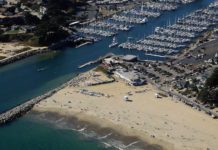If you were rudely awakened this past Saturday night, August 15th, you weren’t alone. A heat wave reaching above 100 degree temperatures have caused many valley residents to open doors and windows at night throughout this week, with hopes for a cool breeze. However, residents got more than they expected at 3 a.m., when huge gusts of wind and a brilliant lightning storm swept across Santa Cruz County. Some folks slept through, others watched from bed, a few saddled up their pup for an impromptu dog walk, and others, like 17-year-old Scotts Valley resident Jackson Damhorst, captured the stunning and fearsome event with their lens. Regardless of how you experienced it, our community is still fighting the storm’s effects.
Lightning strikes, hot temperatures, and winds proved a perfect recipe for fires throughout the County, like the 120-acre Warrenella Fire in Davenport and the 118-acre fire near Waddell Beach. Several smaller fires burned in our valleys, like one in Zayante, off Eagle Tree Lane. Robert Gray, the Felton Fire Protection District Chief, had a moment to discuss fire conditions in San Lorenzo. “There’s so many smaller fires at this point, that it’s difficult to sum up exact numbers, sizes, locations, and states of containment. I can tell you, about 80 to 90% of fires are currently under 10 acres and caused by [lightning] ground strikes… We’ve sent resources to all different areas, mostly assisting neighboring agencies with fires, fallen trees, and downed power lines.” Gray shared the unique difficulties in putting out San Lorenzo Valley fires, “Almost all of our fires are on steep terrain, in difficult to access areas. The fires [still burning in SLV] are in remote areas that makes finding and fighting them difficult… You can see the smoke, but how do you get there?”
While the terrain distinct to San Lorenzo makes firefighters’ tasks quite arduous, Gray gives this advice to ease their burden, “The biggest thing the community can do is be prepared. We get so many calls are from those that aren’t. They find themselves in situations that they could’ve been prepared for. Know your limitations. Figure out a plan for self-sufficiency if you lose power. What are you going to do with medical supplies that require refrigeration? Do you have flashlights, batteries, canned goods? A way to contact loved ones?” Gray adds, “We’re always there to assist in a jam, but if people take the initiative, we can go to more dangerous situations that utilize our specialized training.”
Gray and I then discussed protocol for those aforementioned dangerous situations. “First you need to recognize the situation. If you see or smell smoke, you don’t necessarily need to call 911 right away. With wind shifts, smoke can roll in almost like a fog bank, which is frightening for community members. However, you should only call if a defined column of smoke or flames are in sight.” The Fire Chief touched on another vital resource to keep yourself informed on the current state of fires. “Code Red is an emergency alert system to pass vital information from us to the community. If wires are blocking a road, we can pinpoint where we want the alert to go, maybe it’s a 1/2-mile radius or certain streets. Code Red gives information to community that’s specific to their needs.” However, you must enroll online to receive alerts and, according to Gray, many community members have yet to do so. You can easily enroll for the lifesaving alert service by logging onto https://scr911.org/ and clicking on the Code Red link.
Even if your current living situation is safely away from fire, you can still be at risk from inhalation of smoke. Richard Stedman, the Air Pollution Control Officer of the Monterey Bay Air Resources District shared these helpful guide lines:
· When the concentration of smoke has reached orange, red, purple, or maroon levels of the [Air Quality Index] residents should limit their activity by staying indoors with the doors and windows closed to avoid breathing smoke. You may want to check with your health care provider to make sure it’s not necessary for you to leave the area to where wildfire smoke is diminished or not present.
· Use common sense. If it looks smoky outside, it’s not a good time to exercise or work outside and it’s not a good time for your children to play outdoors.
· Help lower inside particle levels inside your home. When smoke levels are high, avoid using anything that burns, such as wood fireplaces, gas logs, gas stoves – even candles. Don’t vacuum as that stirs up particles already inside your home. And don’t smoke. That puts even more pollution in your lungs, and in the lungs of people around you.
· We are asking residents to avoid adding more pollution to the air by limiting activities such as wood burning, driving, lawn mowing, and leaf blowing. Also, drive your car only if absolutely necessary and combine trips, when possible, to reduce pollution.
With these tips you can stay safe and healthy during wildfire season. Please help ease the strain on our first responders by staying prepared, informed, and aware. If you haven’t yet joined the Code Red alert service, does so at https://scr911.org/. Visit https://gispub.epa.gov/airnow/ for an updated and interactive air quality map. If you’d like to help out the Felton Fire Protection District, they’re now looking for volunteers at https://feltonfire.com/joinus/ .













